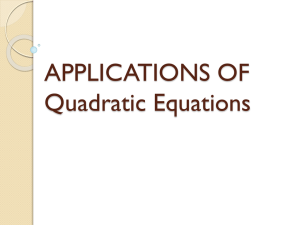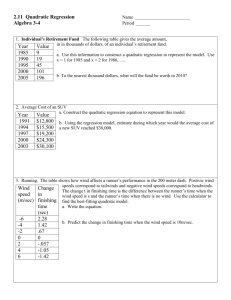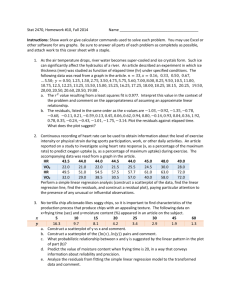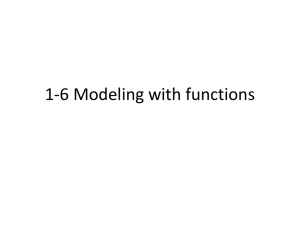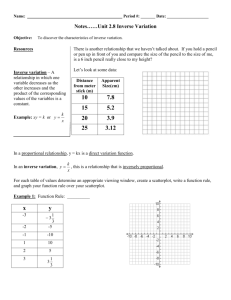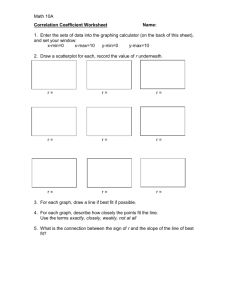AFM Review Unit 3 – Regression Home Schooling Growth The
advertisement
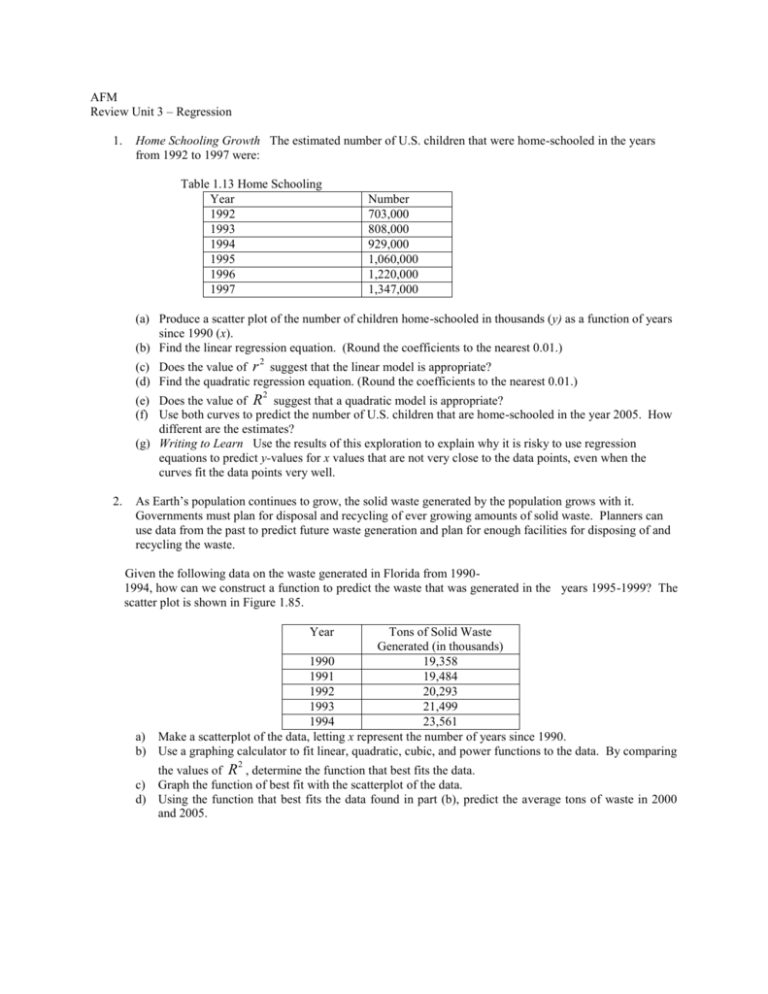
AFM Review Unit 3 – Regression 1. Home Schooling Growth The estimated number of U.S. children that were home-schooled in the years from 1992 to 1997 were: Table 1.13 Home Schooling Year 1992 1993 1994 1995 1996 1997 Number 703,000 808,000 929,000 1,060,000 1,220,000 1,347,000 (a) Produce a scatter plot of the number of children home-schooled in thousands (y) as a function of years since 1990 (x). (b) Find the linear regression equation. (Round the coefficients to the nearest 0.01.) 2 (c) Does the value of r suggest that the linear model is appropriate? (d) Find the quadratic regression equation. (Round the coefficients to the nearest 0.01.) 2 (e) Does the value of R suggest that a quadratic model is appropriate? (f) Use both curves to predict the number of U.S. children that are home-schooled in the year 2005. How different are the estimates? (g) Writing to Learn Use the results of this exploration to explain why it is risky to use regression equations to predict y-values for x values that are not very close to the data points, even when the curves fit the data points very well. 2. As Earth’s population continues to grow, the solid waste generated by the population grows with it. Governments must plan for disposal and recycling of ever growing amounts of solid waste. Planners can use data from the past to predict future waste generation and plan for enough facilities for disposing of and recycling the waste. Given the following data on the waste generated in Florida from 19901994, how can we construct a function to predict the waste that was generated in the years 1995-1999? The scatter plot is shown in Figure 1.85. Year Tons of Solid Waste Generated (in thousands) 1990 19,358 1991 19,484 1992 20,293 1993 21,499 1994 23,561 a) Make a scatterplot of the data, letting x represent the number of years since 1990. b) Use a graphing calculator to fit linear, quadratic, cubic, and power functions to the data. By comparing 2 the values of R , determine the function that best fits the data. c) Graph the function of best fit with the scatterplot of the data. d) Using the function that best fits the data found in part (b), predict the average tons of waste in 2000 and 2005. 3. Leisure Time The following table shows the median number of hours of leisure time that Americans had each week in various years. Year 1973 1980 1987 1993 1997 Source: Louis Harris and Associates Median Number of Leisure Hours Per Week 26.2 19.2 16.6 18.8 19.5 (a) Make a scatterplot of the data, letting x represent the number of years since 1973, and determine which model best fits the data. (b) Use a graphing calculator to fit the type of function determined in part (a) to the data. (c) Graph the equation with the scatterplot. Then, use the function found in part (b) to estimate the number of leisure hours per week in 1978,1990, and 2005. 4. Use the data in the table below to obtain a model for speed p versus distance traveled d. Consider linear, quadratic, exponential, and power models. Then use the model you selected as the best fit to predict the speed of the ball at impact, given that impact occurs when d 1.80 m. Table 2.12 Rubber Ball Data from CBR Experiment Distance (m) 0.00000 0.04298 0.16119 0.35148 0.59394 0.89187 1.25557 5. a) Speed (m/s) 0.00000 0.82372 1.71163 2.45860 3.05209 3.74200 4.49558 Stopping Distance A state highway patrol safety division collected the data on stopping distances in Table 2.16. Table 2.16 Highway Safety Division Speed (mph) Stopping Distance (ft) 10 15.1 20 39.9 30 75.2 40 120.5 50 175.9 Draw a scatter plot of the data. 2 b) Fit linear, quadratic, cubic, and power functions to the data. By comparing the values of R , determine the function that best fits the data. c) Superimpose the regression curve on the scatter plot. d) Use the regression model to predict the stopping distance for a vehicle traveling at 25 mph. e) Use the regression model to predict the speed of a car if the stopping distance is 300 ft. Table 2.16 Highway Safety Division Speed (mph) Stopping Distance (ft) 10 15.1 20 39.9 30 75.2 40 120.5 50 175.9 6. U.S. Farms. As the number of farms has decreased in the United States, the average size of the remaining farms has grown larger, as shown in the table below. Year Average Acreage Per Farm 1910 139 1920 149 1930 157 1940 175 1950 246 1959 303 1969 390 1978 449 1987 462 1997 487 a) Make a scatterplot of the data, letting x represent the number of years since 1900. b) Use a graphing calculator to fit linear, quadratic, cubic, and power functions to the data. By comparing 2 7. the values of R , determine the function that best fits the data. c) Graph the function of best fit with the scatterplot of the data. d) Using the function that best fits the data found in part (b), predict the average acreage in 2000 and 2010. The length of time that a planet takes to make one complete rotation around the sun is its year. The table shows the length (in earth years) of each planet’s year and the distance of that planet from the sun (in millions of miles). Find a model for this data in which x is the length of the year and y the distance from the sum. Planet Mercury Venus Earth Mars Jupiter Saturn Uranus Neptune Pluto 8. Year .24 .62 1 1.88 11.86 29.46 84.01 164.79 247.69 Distance 36.0 67.2 92.9 141.6 483.6 886.7 1783.0 2794.0 3674.5 The following data was obtained by throwing a rubber ball at a CBR. Time (sec) 0.0000 0.1080 0.2150 0.3225 0.4300 0.5375 0.6450 0.7525 0.8600 Height (m) 1.03754 1.40205 1.63806 1.77412 1.80392 1.71522 1.50942 1.21410 0.83173 a) Use the data above to make a scatterplot, letting x represent the number of seconds elapsed. b) Next, use a graphing calculator to find the model that best expresses the height and vertical velocity of the rubber ball. We can also use this model to predict the maximum height of the ball and its vertical velocity when it hits the face of the CBR. 2 Fit linear, quadratic, cubic, and power functions to the data. By comparing the values of R , determine the function that best fits the data. d) Graph the function of best fit with the scatterplot of the data. e) Determine the maximum height of the ball (in meters). f) With the model you selected in part (b), predict when the height of the ball is at least 1.5 meters. c)


